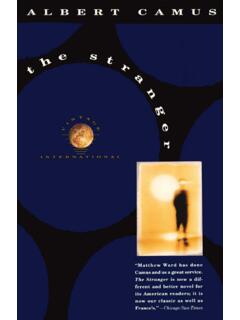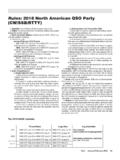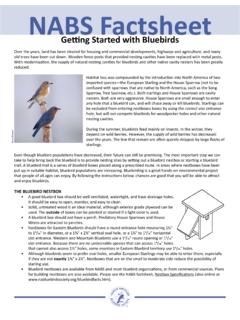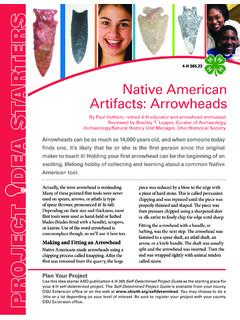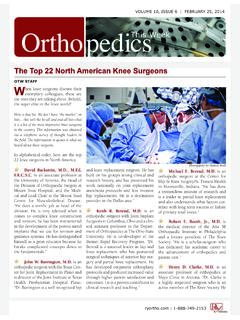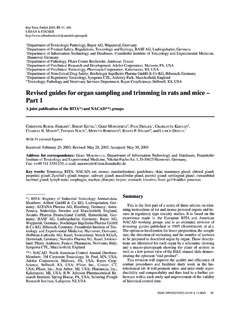Transcription of How Many People Were Here Before Columbus?
1 1 Article 38 How Many People Were Here Before Columbus? One of the few certainties: The Indian populations of north and South America suffered a catastrophic collapse after 1492By Lewis LordGeorge Catlin, the 19th-century art-ist, revered the american Indians anumerous and noble race of HUMANBEINGS, he called them, fast passingto extinction. In the 1830s, he traveledamong four dozen tribes to paint nearly600 portraits and scenes of Indian life;most now hang in the Smithsonian. Dur-ing his visits, his hosts extolled the bliss-ful age Before the settlers came, a timewhen tribes were much larger.
2 The Indi-ans of north America, Catlin wouldspeculate in his diary, were 16 millionsin numbers, and sent that number ofdaily prayers to the Almighty. Few contemporaries agreed with Cat-lin s lofty estimate of the Indian popula-tion Before contact with the white man. Twaddle about imaginary millions, scoffed one Smithsonian expert, reflect-ing the prevailing view that Indians weretoo incompetent to have ever reachedlarge numbers. Alexis de Tocqueville scheery assertion that America Before Co-lumbus was an empty its inhabitants was endorsedby no less than the Census Bureau,which in 1894 warned against acceptingIndian legends as facts.
3 Investigationshows, the bureau said, that the aborig-inal population within the present UnitedStates at the beginning of the Columbianperiod could not have exceeded muchover 500,000. A century later the question remainsfar from settled. But modern scholarshiptends to side with the painter. Some ex-perts believe that perhaps 10 millionpeople lived above the Rio Grande in1492 twice as many as may have in-habited the British Isles at that time. Thepopulation of the Western Hemispheremay have exceeded 15th-century Eu-rope s 70 the higher estimates is therelatively new view that most of Amer-ica s Indians were wiped out by small-pox, measles, and other Old Worlddiseases that swept across the hemi-sphere far faster than the Europeans thatbrought them.
4 Population decay wascatastrophic, concluded historian Will-iam McNeill in his 1976 book, Plaguesand that still leaves unsolved thequestion of how many Indians inhabitedthe continent when the first Europeansarrived. No one, in fact, knows howmany People lived anywhere in thosedays, except for perhaps a city or two inEurope. The first national censuses oc-curred centuries later: 1749 in Sweden,1790 in the fledgling United States, 1801in France and Britain; it was 1953 whenChina took a complete Catlin s means of countingIndians the guesstimate was the onlymethod in his day.
5 It was the samemethod the Census Bureau used in 1894when it haughtily dismissed his idea thatmillions of Indians once inhabited expert whose figures would dom-inate scholarly thought for the first halfof this century, Smithsonian ethnologistJames Mooney, did his share of guess-ing, too. Mooney pored through histori-cal documents for accounts of tribalpopulations made by soldiers, missionar-ies, and others. But he suspected that hissources routinely exaggerated soldiersto paint their conquests as more heroic,missionaries to pad their tallies of soulssaved.
6 So he often took the lowest counthe could find and, to be safe, reduced ultimate tribe-by-tribe estimate, pub-lished in 1928, showed an Indian popula-tion of 1,150,000 north of the RioGrande. Mooney was estimating the popula-tion not in 1492 but in periods that fol-lowed initial contacts with white men including encounters in the AmericanWest as late as the 19th century. Thecommon assumption in his day was thatthe Indians the whites came upon wereprobably as numerous as the Indians of1492. That s what anthropologist AlfredKroeber believed in 1934 when he pro-duced an estimate of the entire hemi-sphere s pre-Columbian population thatdominated academic thought into the1960s.
7 Kroeber took Mooney s tally,shrank it a bit, and extrapolated the fig-Article 38. How Many People Were Here Before Columbus? 2 PHOTOGRAPHS BY EDWARD S. CURTIS FROM THE north american INDIAN COURTESY OF CHRISTOPHER CARDOZO PEOPLES a gallery of portraits ca. 1900 by photographer Edward CurtisANNUAL EDITIONS3ures to the rest of north and South Amer-ica. With a map and a device called aplanimeter, he measured off various cul-tural areas and assigned each a popula-tion density. For the eastern UnitedStates, he averaged fewer than 1 personper square mile.
8 For the many regionsbelow the Rio Grande the lands of theIncas and Aztecs and others that obvi-ously had been much more populous he assigned much higher densities. Hemultiplied the densities by the squaremiles in each region and concluded million People inhabited the Ameri-cas in 1492. They were neatly million in north America and in South America and the count. No one since Kroeberhas made an estimate so low. In the past40 years, scholars have sifted throughthousands of volumes from 16th-cen-tury Spanish reports of baptisms, mar-riages, and tax collections in Mexico to17th-century accounts of epidemics inNew England.
9 Where the data failed toprovide direct answers, the experts de-vised ingenious ways to draw inferencesfrom them. Explorers, for instance,rarely estimated total populations; theytended to report only the number of war-riors. Scholars now multiply the warriorcounts by a correction factor such as 5 tocome up with a total that includeswomen, children, and old men. Multipleslikewise are applied to baptisms, Indianbuildings, even canoes and acres ofbeans and corn. Archaeological sitescontaining heaps of oyster shells havebeen used to estimate how many oysterswere eaten and thus how many Indiansate the 1960s, scholars were conclud-ing that just one spot central Mexico once had three times as many Indians asKroeber had estimated in the highest estimate ever, made in1966, was supported by a provocativetheory.
10 Anthropologist Henry Dobynsargued that disease reduced the Indianpopulation by 95 percent or morethroughout the hemisphere a depopu-lation ratio that, he said, has commonlyGRAPHIC BY STEPHEN ROUNTREE USN&WRSources: american Anthropologist, Current AnthropologyArticle 38. How Many People Were Here Before Columbus? 4occurred even in modern times when ep-idemics strike peoples with no immu-nity. Dobyns took Indian populations attheir nadirs their lowest levels andmultiplied the numbers by 20 or 25. InAmerica above the Rio Grande, for in-stance, the Indian population hit bottomearly in this century when census figuresreported 490,000; by Dobyns s calcula-tion that means between million million Indians once inhabitedwhat s now the United States and Can-ada.
